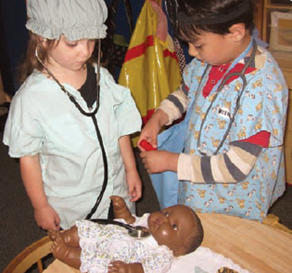14.1: Guiding Principles in Supporting Children’s Health, Safety, and Nutrition
An integrated and comprehensive approach is most effective when preschool children are taught about health. Health education does not stand alone in the preschool curriculum. It is integrated with the other domains. Health is comprehensive. Health education involves ideas directly relevant to the child, such as “How do I grow?” Preschool teachers work with children who are naturally curious and eager to learn about their bodies and how each part works. A developmentally appropriate curriculum promotes overall health (e.g., wellness, safety, oral health, nutrition) and integrates topic areas. For example, a discussion about safety rules might include nutrition and sanitation.

Teachers address ideas and concepts that children can grasp at their developmental level and then progressively build on what children already know and understand. This approach applies to all children, including children with various abilities, disabilities, or other special needs (such as delays in language, cognition, or physical ability).
- Health knowledge is individualized.
- Preschool children and their families possess diverse backgrounds and cultural practices.
- Learning about health practices has a language component.
- Children’s personal health status (i.e., physical, mental, emotional) affects their ability to learn and develop in all domains.
- The overall theme of health education for preschool is personal health.
- Children learn through their experiences, including play, routines and scripts, modeling, and developing and sustaining relationships at preschool. This learning is supported through adult scaffolding.
- Practicing scripts, or behavioral rules, can foster the development of certain health-promoting behaviors or skills.
- The preschool program provides both indoor and outdoor environments that are safe and appropriate, challenging, and inviting for all children.
- Teachers help children feel secure by assuring them that there are adults who will take care of them (e.g., parents, family members, teachers, health care providers, special needs assistants).[1]
- The California Preschool Curriculum Framework, Volume 2 by the California Department of Education is used with permission ↵

